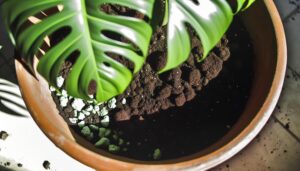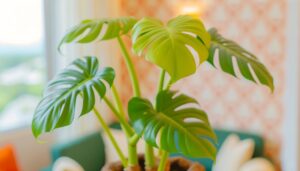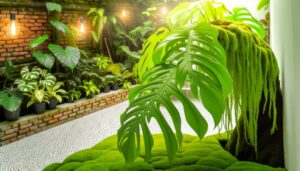Monstera Obliqua Amazonas Vs Peru: A Comparison
When comparing Monstera obliqua Amazon and Peru, you’ll notice clear distinctions. The Amazonas variant has larger leaves with noticeable fenestrations, often reaching 20 cm, thriving in high humidity.
In contrast, the Peru variety features smaller, dense leaves averaging 10 cm with minimal perforations, adapting to various elevations. Both require bright, indirect light but differ slightly in watering needs; Amazonas needs more frequent watering.
Understanding these differences can help tailor your care strategy and maximize growth. Continue exploring for more insights into maintaining these distinctive plants.
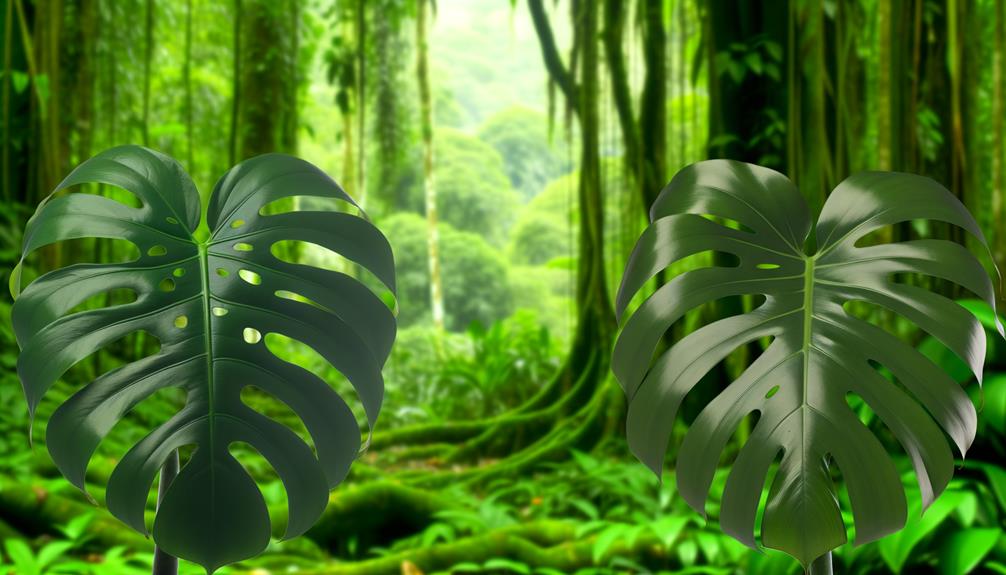
Key Takeaways
- Origin and Habitat: Amazonas comes from humid Amazon rainforests, while Peru adapts to diverse microclimates in Peru.
- Leaf Structure: Amazonas features larger, fenestrated leaves up to 20 cm; Peru has smaller, compact leaves averaging 10 cm.
- Growth Patterns: Amazonas climbs vertically with aerial roots; Peru creeps along the ground.
- Light and Water Needs: Amazonas prefers bright, indirect light and frequent watering; Peru thrives in moderate light and less frequent watering.
- Care Requirements: Both require high humidity, consistent moisture, and well-draining soil with organic matter.
Monstera Obliqua Amazonas vs Monstera Obliqua Peru: Comparison Char
| Feature | Monstera Obliqua Amazonas | Monstera Obliqua Peru |
|---|---|---|
| Leaf Fenestration | Highly fenestrated with more holes than leaf. | Fewer holes, thicker leaves. |
| Leaf Size | Smaller, fragile, and delicate leaves. | Larger, sturdier leaves. |
| Growth Rate | Extremely slow-growing. | Grows faster than Amazonas. |
| Care Difficulty | Requires consistent high humidity and special care. | Similar care but more resilient to environmental changes. |
| Rarity | Extremely rare and hard to source. | Still rare, but more available compared to Amazonas. |
| Price | Higher due to extreme rarity. | Less expensive, but still a premium plant. |
| Origin | Native to the Amazon Rainforest. | Native to Peru and surrounding regions. |
Origin and Habitat
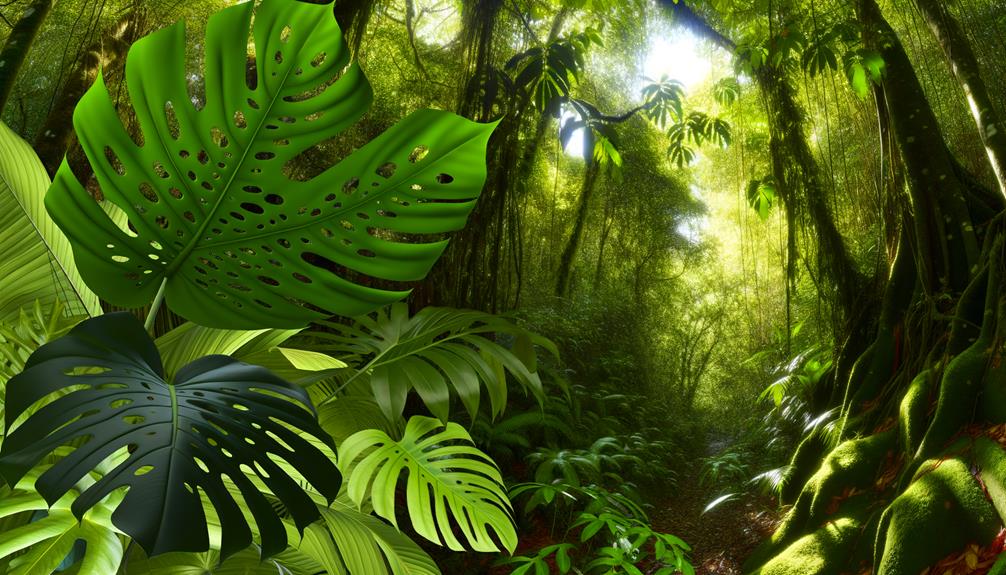
Monstera obliqua Amazonas and Monstera obliqua Peru originate from distinct regions in South America. The former thrives in the dense, humid rainforests of the Amazon basin, while the latter flourishes in the varied elevations of Peru’s tropical and subtropical forests.
You’ll find Monstera obliqua Amazonas in lowland Amazonian ecosystems characterized by high humidity, consistent rainfall, and nutrient-rich soils. This variant prefers shaded understory environments, where it clings to trees for support.
In contrast, Monstera obliqua Peru adapts to a broader range of altitudes, from lowland rainforests to high Andean cloud forests. Its habitat includes areas with fluctuating temperatures and diverse microclimates, requiring adaptability to different light levels and soil types.
This ecological versatility distinguishes these two remarkable Monstera variants.
Leaf Structure
When examining the leaf structure of Monstera Obliqua Amazonas and Peru, you’ll notice distinct differences in size, vein patterns, and texture.
The Amazonas variety typically has larger leaves with more pronounced fenestrations, whereas the Peru variant features smaller, more compact leaves.
Additionally, the vein patterns and leaf thickness vary noticeably, contributing to their unique visual and tactile characteristics.
Leaf Size Comparison
Although both Monstera obliqua Amazonas and Peru belong to the same species, their leaf sizes vary significantly, with the Amazonas variant typically exhibiting larger and more perforated leaves compared to the more delicate and smaller leaves of the Peru variant. The Amazonas leaves can reach up to 20 cm in length, displaying extensive fenestrations, while Peru’s leaves average around 10 cm and feature minimal perforations. This difference can be attributed to their distinct environmental adaptations, influencing their morphology.
| Variant | Leaf Length (cm) | Perforations |
|---|---|---|
| Amazonas | Up to 20 | Extensive fenestrations |
| Peru | Around 10 | Minimal perforations |
You’ll find the Amazonas variant’s larger leaf size more efficient for photosynthesis, whereas Peru’s smaller leaves adapt better to shaded, understory environments.
Vein Pattern Differences
You’ll notice distinct vein patterns in the leaves of Monstera obliqua Amazonas and Peru, with Amazonas displaying more pronounced and interconnected venation compared to the more subtle, linear veins of the Peru variant.
The Amazonas variant showcases a complex network of secondary veins that form a reticulate pattern, enhancing its structural rigidity and aesthetic complexity.
In contrast, the Peru variant features primary veins that run parallel, with minimal branching, giving it a more streamlined and uniform appearance.
These differences in venation influence not only the visual texture but also the physiological functions such as nutrient transport and photosynthesis efficiency.
Texture and Thickness
In addition to vein pattern differences, the texture and thickness of Monstera obliqua leaves further distinguish the Amazonas and Peru variants.
You’ll find that Monstera obliqua Amazonas leaves are exceptionally delicate and almost paper-thin. In contrast, the Peru variety boasts a slightly thicker, more robust leaf structure.
This difference impacts their overall resilience and care requirements.
Here’s what you need to know:
- Amazonas leaves: Fragile, requiring precise humidity control.
- Peru leaves: Thicker, offering greater durability.
- Surface texture: Amazonas leaves have a smoother finish, while Peru leaves exhibit a subtle roughness.
- Porosity: Amazonas exhibit higher porosity, making them more susceptible to environmental changes.
- Growth rate: Amazonas grow slower due to their delicate nature, whereas Peru can sustain faster growth.
Growth Patterns
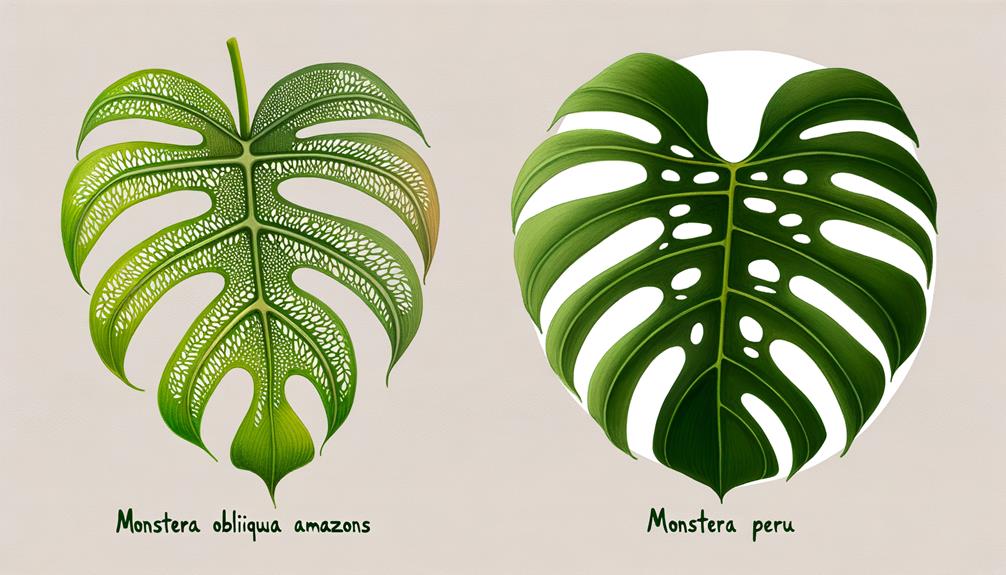
When comparing the growth patterns of Monstera Obliqua Amazonas and Peru, you’ll notice distinct differences in leaf shape, climbing versus creeping behavior, and specific light and water requirements. Amazonas tends to exhibit more pronounced fenestrations and climbs vertically, while Peru often creeps along the ground with less dramatic leaf perforations.
Both varieties, however, demand high humidity and consistent moisture to thrive at their best.
Leaf Shape Differences
Unlike the Monstera obliqua Amazonas, which showcases highly perforated, lace-like leaves, the Monstera obliqua Peru exhibits a more moderate fenestration pattern with fewer and smaller holes. The leaf morphology differences stem from their distinct genetic adaptations and environmental conditions. The Amazonas’ leaves are paper-thin, maximizing light capture through ample perforations, while the Peru’s leaves are thicker, optimizing structural integrity.
Key distinctions include:
- Leaf Thickness: Amazonas has ultra-thin leaves; Peru’s are sturdier.
- Hole Size: Amazonas features larger, more irregular holes; Peru’s are smaller and more uniform.
- Fenestration Density: Amazonas exhibits higher perforation density.
- Leaf Shape: Amazonas leaves are more elongated.
- Surface Texture: Amazonas leaves are smoother, while Peru’s have a slightly rugged texture.
Understanding these differences helps you identify and care for each variety effectively.
Climbing Vs. Creeping
Have you ever wondered how the growth patterns of Monstera obliqua Amazonas and Peru differ when it comes to climbing and creeping behaviors?
Monstera obliqua Amazonas mainly exhibits a climbing habit, utilizing aerial roots to ascend tree trunks in its native rainforest habitat. Its growth is facilitated by the presence of structural supports, enabling it to reach light sources more efficiently.
Conversely, Monstera obliqua Peru tends to display more creeping behavior, spreading horizontally along the forest floor. This growth pattern allows it to cover ground quickly, creating a dense mat of foliage.
Both species adapt their growth strategies to optimize resource acquisition, but their structural differences highlight their unique ecological niches. Understanding these patterns aids in proper cultivation techniques.
Light and Water Needs
Understanding the distinct climbing and creeping behaviors of Monstera obliqua Amazonas and Peru underscores the significance of tailoring their light and water requirements to their unique growth patterns.
Monstera obliqua Amazonas, which climbs, prefers bright, indirect light and consistent moisture to support its aerial roots.
On the other hand, Monstera obliqua Peru, which creeps, thrives in moderate, diffused light and requires less frequent watering due to its extensive root system.
- Light Needs:
Bright, indirect light for Amazonas; moderate, diffused light for Peru.
- Watering Frequency:
Frequent for Amazonas; less frequent for Peru.
- Humidity:
Both species thrive in high humidity environments.
- Soil Type:
Well-draining, aerated soil is essential for both.
- Growth Support:
Provide a climbing structure for Amazonas; a wide pot for Peru.
Tailor these conditions to optimize their growth.
Light Requirements
Both Monstera Obliqua Amazonas and Peru thrive in bright, indirect light, imitating their natural understory rainforest habitat. You’ll want to position these plants where they receive filtered sunlight, such as behind a sheer curtain or in a room with ample ambient light but no direct sun exposure. Direct sunlight can scorch their delicate leaves, causing discoloration and damage.
To ensure ideal growth, provide 10-12 hours of light daily. If natural light is insufficient, consider using grow lights with a spectrum of 4000K to 6500K. Measure light intensity with a lux meter; aim for 10,000 to 20,000 lux.
Watering Needs
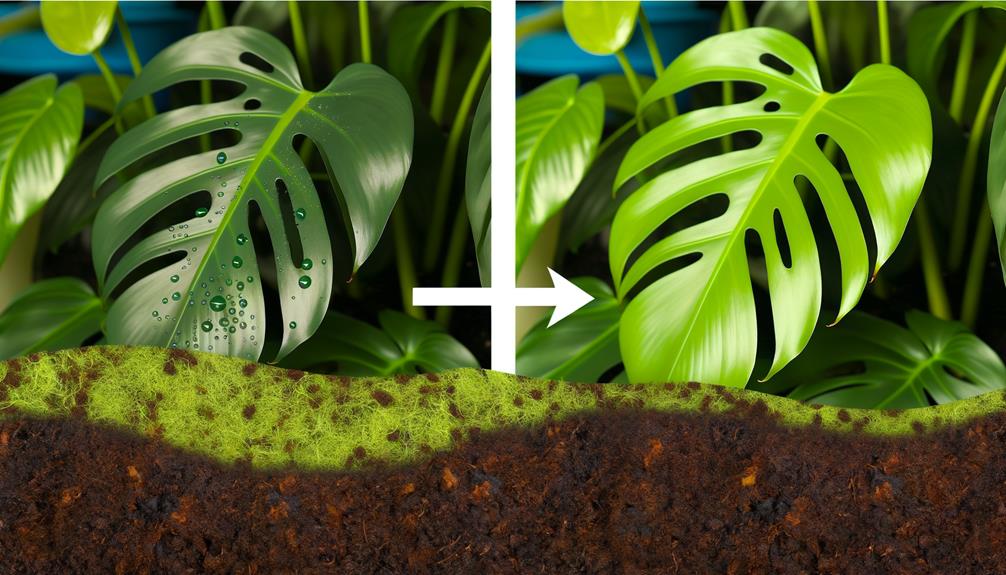
Securing proper watering for Monstera Obliqua Amazonas and Peru involves maintaining consistently moist but not saturated soil to mimic their natural humid environments. You should water them thoroughly when the top inch of soil feels dry, securing even moisture throughout the root zone. Always use room-temperature water to avoid shocking the roots.
- Frequency: Water once a week during the growing season; reduce in winter.
- Humidity: Maintain 60-80% humidity using a humidifier or misting.
- Drainage: Guarantee pots have drainage holes to prevent waterlogging.
- Water Quality: Use filtered or rainwater to avoid chlorine and fluoride.
- Signs of Overwatering: Yellow leaves, root rot, and mushy stems.
Soil Preferences
Selecting the right soil for Monstera Obliqua Amazonas and Peru is crucial, as they thrive in a well-aerated, loose, and nutrient-rich mix. You should use a substrate containing components like perlite, orchid bark, and peat moss. These elements ensure peak drainage and aeration, preventing root rot.
Aim for a pH level between 5.5 and 7.0, which is slightly acidic to neutral, facilitating nutrient uptake. Incorporating organic matter, such as compost or worm castings, can enhance soil fertility and microbial activity. Avoid heavy, compacted soils, as they impede root growth and water flow.
Regularly check the soil’s texture and moisture level to maintain an ideal growing environment for these tropical aroids.
Temperature and Humidity

In addition to ideal soil conditions, maintaining specific temperature and humidity levels is essential for the health of Monstera Obliqua Amazonas and Peru. These tropical plants thrive in environments that mimic their native habitats. You should aim for temperatures between 65°F to 80°F (18°C to 27°C) and humidity levels above 60%.
Key points to keep in mind:
- Temperature Range: Maintain a consistent temperature of 65°F-80°F.
- Humidity Levels: Aim for humidity above 60%.
- Avoid Drafts: Keep the plant away from cold drafts and sudden temperature changes.
- Humidity Boosters: Use humidifiers or pebble trays to increase humidity.
- Monitor Microclimate: Regularly check the microclimate around your plant using hygrometers and thermometers.
Common Pests
Unfortunately, Monstera Obliqua Amazonas and Peru are frequently susceptible to common pests such as spider mites, mealybugs, and scale insects. These pests can cause significant damage, leading to yellowing leaves, stunted growth, and weakened plants. Spider mites, often found on the undersides of leaves, produce fine webbing and suck sap from the plant. Mealybugs appear as white, cotton-like masses and can spread quickly. Scale insects attach themselves to stems and leaves, forming small, brown, hard-to-remove bumps. Regular inspection and prompt treatment are essential for maintaining plant health.
| Pest | Description |
|---|---|
| Spider Mites | Fine webbing, sap-sucking, yellowing leaves |
| Mealybugs | White, cotton-like masses, rapid spread |
| Scale Insects | Small, brown bumps, attach to stems/leaves |
| Thrips | Tiny, slender insects, cause silvery streaks |
| Fungus Gnats | Small flies, larvae feed on roots |
Consistent monitoring and appropriate treatments are crucial to manage these pests.
Propagation Methods
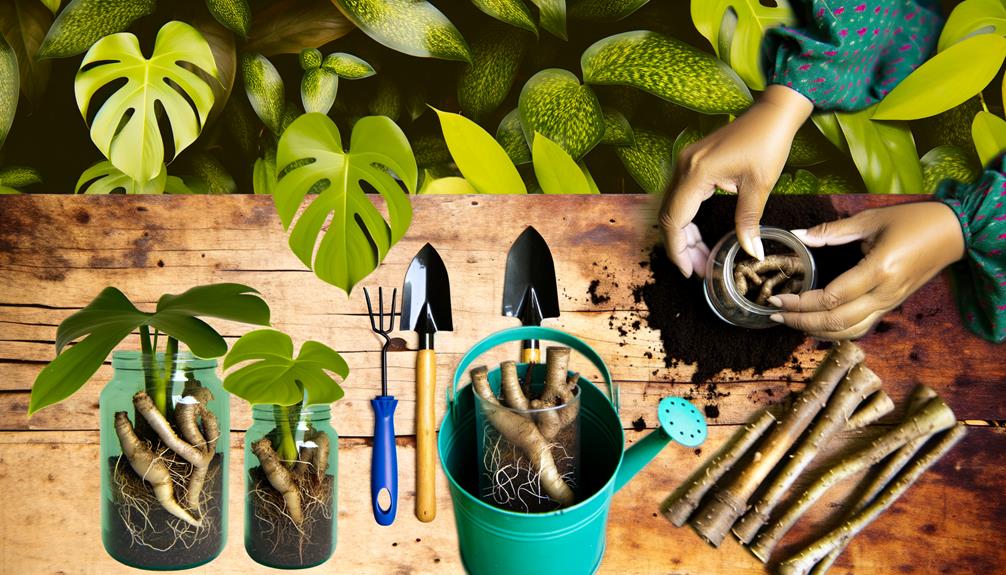
Propagation of Monstera Obliqua Amazonas and Peru typically relies on the effective use of stem cuttings to guarantee successful growth and development. You’ll want to cut a healthy stem section, ensuring it has at least one node and aerial root. Place the cutting in water or moist sphagnum moss, maintaining high humidity and indirect light.
- Select a cutting: Choose stems with 2-3 nodes and healthy leaves.
- Sterilize tools: Use alcohol to clean pruning shears to prevent disease.
- Rooting medium: Water or sphagnum moss works well; keep it moist.
- Humidity: Maintain 70-90% humidity using a humidity dome or plastic bag.
- Lighting: Provide bright, indirect light to stimulate root growth.
Monitor closely for root development, which typically takes several weeks.
Conclusion
You might think distinguishing between Monstera obliqua Amazonas and Peru is trivial, but it’s crucial for best care. Recognizing their distinct leaf structures, growth patterns, and habitat needs guarantees vigorous growth.
Both species require particular light, watering, and soil conditions, and comprehending these can prevent typical pests and diseases. By mastering their propagation methods, you’re not just growing plants; you’re nurturing a flourishing, scientifically captivating environment.
Don’t underestimate the advantages of accurate care.

